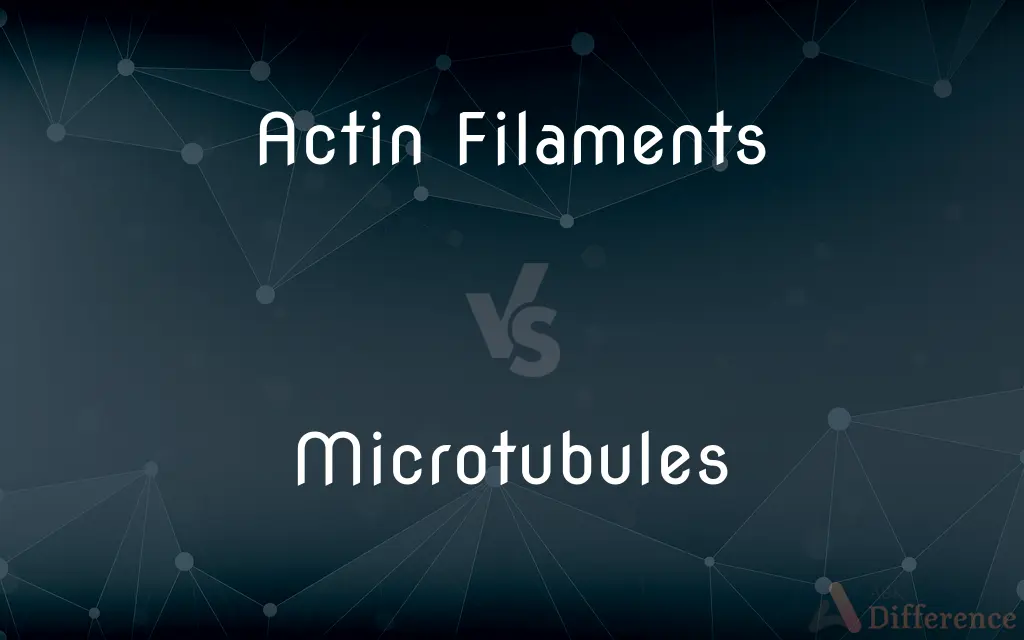Actin Filaments vs. Microtubules — What's the Difference?
Edited by Tayyaba Rehman — By Urooj Arif — Published on August 9, 2024
Actin filaments are thin, flexible protein fibers crucial for cell movement and shape, while microtubules are thicker, rigid tubes that provide structural support and facilitate intracellular transport.

Difference Between Actin Filaments and Microtubules
Table of Contents
ADVERTISEMENT
Key Differences
Actin filaments, also known as microfilaments, are the thinnest filaments of the cytoskeleton in eukaryotic cells. They are primarily composed of the protein actin and are involved in various cellular functions including muscle contraction, cell motility, and the maintenance of cell shape. Actin filaments are dynamic structures, rapidly assembling and disassembling to enable cell movement and changes in cell structure.
Microtubules, on the other hand, are much thicker than actin filaments and are composed of tubulin proteins. They serve as the primary scaffolding of the cell, maintaining its shape by resisting compressive and bending forces. Microtubules also play a key role in cell division by forming the mitotic spindle, which separates chromosomes during mitosis. Additionally, they are crucial for intracellular transport, with motor proteins walking along microtubules to carry cellular components to their destinations.
Both actin filaments and microtubules are essential for maintaining cell structure and facilitating movement, but they differ significantly in their composition, diameter, and specific functions within the cell. Actin filaments are more involved in forming the cell's cortex and enabling movements like crawling and contraction, while microtubules are involved in more rigid structural support, transport of vesicles, and chromosomal separation during cell division.
The dynamic instability of microtubules, characterized by rapid growth and shrinkage, contrasts with the more stable but still flexible nature of actin filaments, which can rapidly polymerize and depolymerize as well. This dynamic behavior allows cells to adapt quickly to changes in their environment or during development and division.
Actin filaments and microtubules are both critical components of the cell's cytoskeleton but have distinct roles due to their different properties and functions. Understanding these differences is essential for comprehending how cells maintain their shape, move, and divide.
ADVERTISEMENT
Comparison Chart
Composition
Actin protein
Tubulin proteins
Diameter
Approximately 7 nm
Approximately 25 nm
Flexibility
Flexible, with the ability to form tight bends
Rigid, resist bending and compression
Functions
Cell shape, muscle contraction, cell motility, cytokinesis
Cell shape, intracellular transport, cell division (mitotic spindle)
Dynamic Behavior
Rapid assembly/disassembly
Dynamic instability (rapid growth and shrinkage)
Location in Cell
Concentrated near the cell surface
Extends from the centrosome throughout the cell
Interaction with Motor Proteins
Works with myosin
Works with dynein and kinesin
Compare with Definitions
Actin Filaments
Actin filaments are protein fibers that play a key role in cell movement and structure.
Actin filaments enable the contraction of muscle cells.
Microtubules
Microtubules form the mitotic spindle during cell division.
They ensure accurate chromosome segregation into daughter cells.
Actin Filaments
Actin filaments are involved in cytokinesis, splitting a cell into two.
During cell division, actin filaments form a contractile ring that divides the cell.
Microtubules
Microtubules are cylindrical structures that provide support and facilitate transport within cells.
Microtubules guide organelles to their destinations within the cell.
Actin Filaments
They provide mechanical support to microvilli.
Actin filaments maintain the structure of microvilli in intestinal cells.
Microtubules
They are crucial for intracellular transport, working with motor proteins.
Kinesin moves cargo along microtubules towards the cell's periphery.
Actin Filaments
Actin networks are essential for cellular processes like endocytosis.
Actin filaments facilitate the invagination of the plasma membrane during endocytosis.
Microtubules
Microtubules help maintain cell shape by resisting compressive forces.
In neurons, microtubules support the long extensions of axons and dendrites.
Actin Filaments
They are composed of actin monomers and are highly dynamic.
Actin polymerization drives the extension of cell protrusions in migrating cells.
Microtubules
They are made from tubulin dimers and have inherent polarity.
The plus end of a microtubule exhibits faster growth than the minus end.
Microtubules
Any of the cylindrical hollow tubulin-containing structures that are found in the cytoplasm, cilia, and flagella of eukaryotic cells and are involved in determining cell shape and structure and directing the movement of organelles and chromosomes. Microtubules, along with microfilaments and intermediate filaments, make up a cell's cytoskeleton.
Microtubules
Plural of microtubule
Common Curiosities
Can actin filaments and microtubules work together?
Yes, both components of the cytoskeleton can coordinate for cell movement, division, and structural integrity, often interacting indirectly through other cellular mechanisms.
How do actin filaments and microtubules differ in structure?
Actin filaments are made of actin proteins and are flexible, while microtubules are composed of tubulin proteins and are more rigid.
Why is the dynamic nature of actin filaments and microtubules important?
Their ability to rapidly assemble and disassemble allows the cell to change shape, move, and divide in response to internal and external cues.
What roles do actin filaments play in muscle contraction?
Actin filaments interact with myosin to produce the force required for muscle contraction.
What is the significance of the flexibility of actin filaments?
It allows actin filaments to form various structures like tight bundles or loose networks, adapting to different cellular needs.
What are the main functions of actin filaments and microtubules?
Actin filaments are involved in cell movement, shape, and division, while microtubules provide structural support, facilitate intracellular transport, and are involved in cell division.
How do motor proteins interact with actin filaments and microtubules?
Myosin moves along actin filaments, while kinesin and dynein move along microtubules, facilitating the transport of cellular components.
How do microtubules contribute to cell division?
They form the mitotic spindle, which helps segregate chromosomes during mitosis.
What is dynamic instability in the context of microtubules?
It refers to the rapid growth and shrinkage of microtubules, allowing them to explore the cellular space and perform functions like intracellular transport and cell division.
How does the cell regulate the assembly of actin filaments and microtubules?
The cell uses a variety of proteins to nucleate, elongate, cap, and sever filaments and tubules, controlling their dynamics according to cellular needs.
Share Your Discovery

Previous Comparison
Photo vs. Photocopy
Next Comparison
Soccer Cleats vs. Softball CleatsAuthor Spotlight
Written by
Urooj ArifUrooj is a skilled content writer at Ask Difference, known for her exceptional ability to simplify complex topics into engaging and informative content. With a passion for research and a flair for clear, concise writing, she consistently delivers articles that resonate with our diverse audience.
Edited by
Tayyaba RehmanTayyaba Rehman is a distinguished writer, currently serving as a primary contributor to askdifference.com. As a researcher in semantics and etymology, Tayyaba's passion for the complexity of languages and their distinctions has found a perfect home on the platform. Tayyaba delves into the intricacies of language, distinguishing between commonly confused words and phrases, thereby providing clarity for readers worldwide.











































